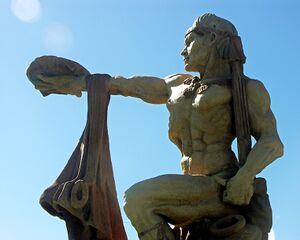كاكتيو
 أمة الكاكتيو، تحت Cacique Manaure | |
| المناطق ذات التجمعات المعتبرة | |
|---|---|
| اللغات | |
| كاكتيو | |
| الدين | |
| أديان تقليدية | |
| الجماعات العرقية ذات الصلة | |
| Arawak, Quiriquire, Jirajara |
كاكتيو Caquetio أو كايكتيو Caiquetio، أو كايكتيا Caiquetia هم السكان الأصليون لشمال غرب Venezuela, living along the shores of Lake Maracaibo at the time of the Spanish conquest. They moved inland to avoid enslavement by the Spaniards, while their numbers were drastically affected by colonial warfare, as were their neighbours, the Quiriquire and the Jirajara. The Caquetíos were also present in Aruba, Curaçao and Bonaire when these islands were first colonized by Alonso de Ojeda in 1499. The occupants of this region were known as Caquetíos by the Spaniards and their language (Caquetío) belongs to the Arawakan family of languages. The Caquetío and the Jirajara spoke the same language, and their cultures were quite similar. The Arawakan or Caquetío language is termed a "ghost" language because virtually no trace of it survives. Only the name remains, saved in 17th-century texts.[1]
آروبا وكوراساو وبونير
When the Spanish arrived in Aruba around 1500 they found the Caiquetios in Aruba, living much as they did in the Stone Age. The Caiquetios had probably migrated to Aruba, Curaçao and Bonaire in canoes made from hollowed out logs they used for fishing. Such crossings from the Paraguana peninsula in Venezuela, across the 17 miles (27 km) of open sea to Aruba, would be possible in the canoes the Caiquetios of Venezuela built.
أماكن الاستيطان في ڤنزويلا وكولومبيا
"This nation is very large, but lives in many areas separated from each other,"[2] so the summary of the 16th century chronicler Juan de Castellanos.
ببليوگرافيا
- (1948). Handbook of South American Indians. Volume 4. Washington: Smithsonian Institution.
- Hertog, Johannes (1961). History of the Netherlands Antilles. Dewitt.
- Hutkrantz, Ake (1979). The Religions of the American Indians. M. Setterwall, trans. Berkeley: University of California Press.
- Steward, Julian et al., eds (1959). Native Peoples of South America. New York: McGraw Hill.
- Gonzalo Fernández de Oviedo y Valdés: Historia General y Natural de las Indias. Madrid 1959.
- Juan de Castellanos: Elegías de varones ilustres de Indias. Bogotá 1997.
- Indianische Historia; Nicolaus Federmann. Introduction by Juan Friede. München 1965.
الهامش
- ^ «Caquetío» Encyclopædia Britannica
- ^ Castellanos, Juan de (1997). Elegías de varones ilustres de Indias. Bogotá. p. 411.
{{cite book}}: CS1 maint: location missing publisher (link)
